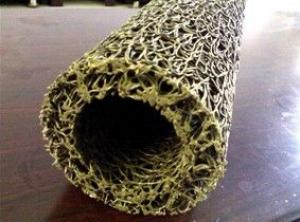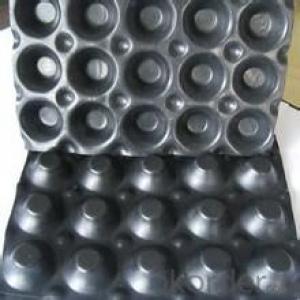Multi-Purpose White Extruded Plastic Anti Bird
- Loading Port:
- China main port
- Payment Terms:
- TT OR LC
- Min Order Qty:
- 5000 m²
- Supply Capability:
- 1000000 m²/month
OKorder Service Pledge
OKorder Financial Service
You Might Also Like
Plastic netting plastic mesh breeding mesh
Plastic Plain Netting
Colour:white,black,blue and green



Deer fence introduction:
Deer fencing is a very high strength, lightweight, 3.6ft to 7.3ft high deer fence manufactured from high strength polypropylene BOP plastic netting. Deer have a tendency to forage over large areas and the cost effective deer fencing offers a very effective deer control barrier.
The deer fence is black, UV stabilised and rot proof and unobtrusive as it merges into it's background. Deer fencing is very quick and easy to erect and each roll weighs less than 15kg. The Deer Netting should be installed by battening to the fencing posts to ensure the mesh filaments are not damaged.
Features of the deer neeting fence:
Deer fence is easy to erect and install
Plastic netting has a mesh hole size of 0.06" ,0.08",0.18",0.19"
The BOP plastic netting has a high tensile strength
Plastic mesh is UV stabilized and chemical resistant
Deer fencing rolls are lightweight
Deer fencing is a very high strength, lightweight 1.8m high Deer fence manufactured from polypropylene.
Deer fencing net is supplied on a 100m long roll
Features:
1. Low cost, while has superior strength
2. Has anti-tearing and friction capability
3. Wide range of product availability, some other mesh sizes and weights can also produced as per customers' requirements.
Package/Payment/Delivery:
Package: Usually packed by rolls in plastic film bags with labels inside and then loosely loaded in the container
FAQ:
Q1: What is your minimum order quantity?
A:The minimum order quantity is 5000 ,but it is negotiable.
Q2:What is your payment terms?
A: T/T,Western Union,Paypal,L/C...
Q3:What is your delivery time?
A:Production time usually costs 2-20 days.
Waiting to cooperate with you!
- Q: What are the advantages of using geosynthetic clay liners in irrigation canals?
- Geosynthetic clay liners offer several advantages when used in irrigation canals. Firstly, they have excellent hydraulic conductivity, allowing for efficient water flow and distribution. Secondly, they provide a high level of resistance against seepage, preventing water loss and ensuring a consistent water supply for irrigation. Additionally, geosynthetic clay liners are durable and have a long lifespan, reducing the need for frequent replacements. They are also easy to install, saving time and labor costs. Lastly, these liners are environmentally friendly, as they are made from natural clay materials and do not release harmful chemicals into the surrounding soil or water.
- Q: What are the advantages of using precast concrete products?
- There are several advantages of using precast concrete products. Firstly, precast concrete offers a high level of quality control as it is manufactured in a controlled environment, ensuring consistent and reliable results. Secondly, precast concrete products provide faster construction as they can be produced in advance and installed quickly on-site, reducing project timelines. Additionally, precast concrete offers versatility in design and can be customized to meet specific project requirements. It is also a durable and long-lasting material that requires minimal maintenance. Lastly, precast concrete products are eco-friendly as they can be recycled and reused, reducing waste and minimizing the environmental impact of construction projects.
- Q: Can earthwork products be used in underground storage applications?
- Yes, earthwork products can be used in underground storage applications. These products, such as geotextiles and geosynthetics, are commonly used to reinforce and stabilize the ground in underground storage facilities, providing additional strength and durability to the structure. They help prevent soil erosion, improve drainage, and enhance the overall performance and lifespan of the underground storage system.
- Q: Are earthwork products suitable for constructing decorative walls?
- Yes, earthwork products, such as natural stone, bricks, concrete blocks, or even rammed earth, can be excellent materials for constructing decorative walls. These materials offer a wide range of textures, colors, and shapes, allowing for creative and visually appealing designs. Additionally, earthwork products are durable, sustainable, and can blend well with the surrounding environment, making them suitable for constructing decorative walls in various settings, such as gardens, parks, or residential spaces.
- Q: What are the different cost considerations for earthwork products?
- The different cost considerations for earthwork products include the type and quality of materials used, the complexity and scale of the project, the labor and equipment required, site conditions and accessibility, transportation and logistics, permits and regulatory requirements, and any additional services or features requested.
- Q: What are the different applications of geotextile bags?
- Geotextile bags have various applications, including erosion control, shoreline protection, land reclamation, riverbank stabilization, sediment containment, and dewatering during construction projects. They are also used in agriculture for soil erosion prevention and in environmental engineering for waste containment and filtration.
- Q: How are earthwork products different from regular construction materials?
- Earthwork products are different from regular construction materials because they are derived from natural sources such as soil, clay, and gravel, whereas regular construction materials are often manufactured or processed materials like concrete, steel, or bricks. Earthwork products are primarily used for shaping and modifying the terrain, such as grading, excavating, or filling, whereas regular construction materials are used for structural purposes, like building foundations, walls, or roofs.
- Q: What is the purpose of using geocomposites in subsurface drainage systems?
- The purpose of using geocomposites in subsurface drainage systems is to enhance the efficiency and longevity of the drainage system. Geocomposites are engineered materials that combine geotextiles with other components like drainage cores or geonets. These materials help to improve filtration, water flow, and soil stabilization in drainage systems. They provide a barrier against soil clogging, prevent the intrusion of fines, and facilitate the collection and removal of excess water from the subsurface. Ultimately, geocomposites help to prevent waterlogging, soil erosion, and maintain the overall stability and functionality of the subsurface drainage system.
- Q: What are the advantages of using geosynthetic materials in road shoulder construction?
- There are several advantages of using geosynthetic materials in road shoulder construction. Firstly, geosynthetics provide excellent soil stabilization, preventing erosion and maintaining the integrity of the road structure. Secondly, they can improve drainage by allowing water to pass through while preventing soil particles from clogging the system, thus reducing the risk of water-related damage. Thirdly, geosynthetics are durable and resistant to degradation, ensuring long-lasting performance and reducing the need for frequent maintenance. Lastly, these materials are lightweight and easy to install, resulting in cost and time savings during construction. Overall, geosynthetics offer numerous benefits for road shoulder construction, enhancing the safety, durability, and efficiency of the road network.
- Q: How do earthwork products contribute to soil moisture retention?
- Earthwork products, such as mulch, compost, and soil amendments, play a crucial role in improving soil moisture retention. These products help to create a favorable environment for water infiltration and retention by enhancing the soil's structure and increasing its water-holding capacity. Mulch, for example, acts as a protective layer, reducing evaporation and soil temperature, thereby minimizing moisture loss. Compost and soil amendments improve soil structure, increasing its ability to hold water and reducing runoff. Overall, earthwork products contribute to soil moisture retention by creating a more water-efficient and resilient soil environment.
Send your message to us
Multi-Purpose White Extruded Plastic Anti Bird
- Loading Port:
- China main port
- Payment Terms:
- TT OR LC
- Min Order Qty:
- 5000 m²
- Supply Capability:
- 1000000 m²/month
OKorder Service Pledge
OKorder Financial Service
Similar products
Hot products
Hot Searches
Related keywords




























